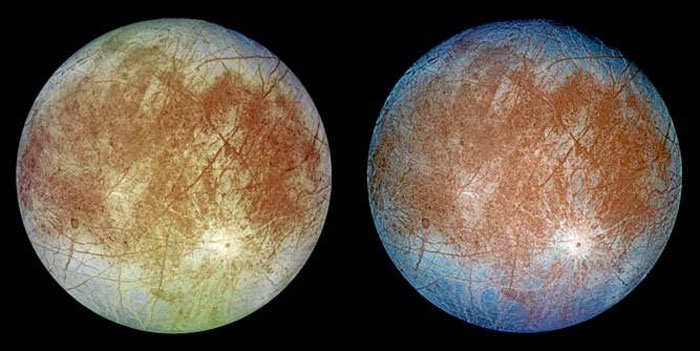.

Two images of Jupiter’s ice-covered moon. The left images shows the approximate natural color appearance of Europa. The image on the right is a false-color composite combining violet, green and infrared images to enhance color differences in the icy water encrusting Europa. Photo courtesy of the Jet Propulsion Laboratory
.
LA CAÑADA FLINTRIDGE >> Discolored sea salt from Jovian moon Europa’s subsurface ocean is likely the reason for dark brown material on the icy orb, NASA scientists said Tuesday.
Sea salt on Europa’s surface suggests the ocean is interacting with a rocky seafloor, an important factor to determine if the icy moon could support life.
The mysterious dark material along linear fractures and other relatively young geological features on Europa has confused scientists for more than a decade. It could be traditional white salt turned brown through radiation exposure, said Kevin Hand, research lead of a study reporting laboratory results that simulated Europa’s environment in order to test possible culprit substances.
“We call it our ‘Europa in a can,’” Hand, a planetary scientist at NASA’s Jet Propulsion Laboratory, said in a statement. “The lab setup mimics conditions on Europa’s surface in terms of temperature, pressure and radiation exposure.”
Results of the NASA study are available on the website of journal Geophysical Research Letters.
“Research like this is important because it focuses on questions we can definitively answer, like whether or not Europa is inhabitable,” said Curt Niebur, Outer Planets Program scientist at NASA Headquarters in Washington, in a statement. “Once we have those answers, we can tackle the bigger question about life in the ocean beneath Europa’s ice shell.”
Previous studies using data from NASA’s Galileo spacecraft and some telescopes credited the discoloration on Europa’s surface to compounds containing sulfur and magnesium. Although radiation-processed sulfur is responsible for some of the colors on Europa, the new NASA experiments show that irradiated salts could explain the color in the youngest regions of Europa’s surface.
Europa is surrounded by radiation from Jupiter’s powerful magnetic field. Electrons and ions hurl themselves into the moon’s surface with the fervor of a particle accelerator. NASA scientists simulated Europa’s environment to collect spectra or chemical fingerprints.
“The spectra of these materials can then be compared to those collected by spacecraft and telescopes,” Hand said in a statement.
In the study, scientists tested samples of common salt as well as mixtures of salt and water in a vacuum chamber of minus 280 degrees Fahrenheit. They fired the salty samples with electron beams to simulate the intense radiation on Europa’s surface.
Tens of hours of exposure corresponds to up to a century in Europa’s harsh environment. The white samples of salt turned yellow-ish brown, resembling the coloring on Europa as imaged by NASA’s Galileo mission, researchers said. A deeper, darker color came from samples that were able to bathe in radiation longer. Scientists may be able to use shades of yellowish-brown coloring to determine the age of items on Europa, Hands said.
Quelle: Pasadena Star News
4645 Views
